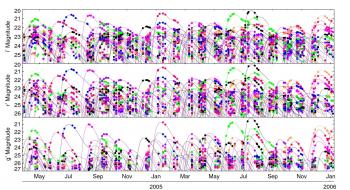
Light curves of supernova candidates detected by SNLS over 18 months. Ten new events were typically detected every month in each field. Three filters among the four used by SNLS are shown. Credit: SNLS collaboration.
Supernovae were searched for in deep images (integrated exposure time of about one hour per night in each filter) taken by MegaCam at the CFHT. To ensure detections throughout the year, the same four 1 square degree fields of view were repeatedly observed, each field being visible from Hawaii during around 7 months a year.
Two fields were observed simultaneously by SNLS at each epoch of the year. Supernovae were detected by an increase of flux with respect to that of their host galaxies. To measure fluxes, images were taken every three or four days outside full moon periods. Four broadband filters (or frequency bands) were used, from optical to near infrared bands, to cover the entire wavelength interval spanned by supernova spectra.
To obtain supernova types and redshifts for all objects detected and followed at CFHT, spectra were measured (with integrated exposure times of 40 min to 1 hour, depending on the supernova flux) on 8 m partner telescopes, namely the VLT (Chile), Gemini (Chile and Hawaii) and Keck (Hawaii) telescopes.
Irfu contributions:
Technical divisions (DEDIP, DIS): design and assembly of MegaCam, the largest CCD camera in astronomy (more than 300 million pixels) when installed in 2003. MegaCam allows 1-degree square regions of the sky to be covered in one pointing.
Physics division (DPhP): the group analysed SNLS data to search for supernovae using only photometry, thus anticipating what was going to be the strategy of later distant supernova detection programs (such as the current one on DES or the future LSST supernova search).
More recently, the group explored the hypothesis of modified gravity to explain the late acceleration of the Universe expansion rate, discovered and confirmed by distant supernova studies, as well as by other astrophysical phenomena (cosmic microwave background, baryonic acoustic oscillations).

